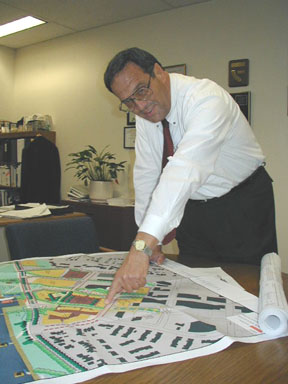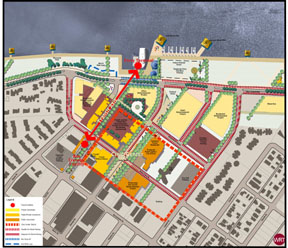The right location, the right people, a dedicated group of riders, and a long series of significant events came together during the past fifteen years, resulting in the creation of the most dynamic ferry service on San Francisco Bay today. From a modest beginning in 1986, ferry service between Vallejo and San Francisco has grown to today’s highly successful Vallejo Baylink.

Alvaro da Silva, Vallejo’s Director of Economic Development, with plans for Vallejo’s waterfront revival
By Michael Setty
Published: July, 2001
The right location, the right people, a dedicated group of riders, and a long series of significant events came together during the past fifteen years, resulting in the creation of the most dynamic ferry service on San Francisco Bay today. From a modest beginning in 1986, ferry service between Vallejo and San Francisco has grown to today’s highly successful Vallejo Baylink.
Currently, two state-of-the-art 35-knot, 301-passenger catamarans (the M/V Intintoli and M/V Mare Island) provide eleven round trip sailings per day between Vallejo and San Francisco. Nonetheless our ferries are commonly crowded beyond capacity, routinely bumping passengers onto supplemental buses. In all, Baylink served 535,000 passengers during 1998, the first full year of expanded operation. Yet about 800,000 passengers are predicted for 2001 and more than a million riders are projected for 2004, after Baylink places a 3rd ferryboat into regular weekday operation. According to Vallejo’s Transportation Superintendent Pam Belchamber, "The ultimate test of a transit system is its patronage. There is no doubt that Baylink’s overwhelming success has put Vallejo on the Bay Area transit map."
The overwhelming success of Baylink has been one of the factors inspiring the recent creation of the Bay Area Water Transit Authority (WTA). Baylink has also integrated two of the most important functions of municipal government in Vallejo – transportation and economic development. Vallejo’s Mayor Anthony "Tony" Intintoli, who also serves on the WTA board, has a broad vision of reuniting the city’s downtown and waterfront areas together, as they were before the redevelopment programs of the 1960s. He would extend the city’s major east-west streets to the waterfront and bring unity to the city’s central core. So, this fall, Georgia Street will be extended and will terminate directly in front of the Ferry Terminal, reuniting the waterfront and downtown areas.
Mayor Intintoli strongly believes that Baylink ferries have already enhanced economic development of Vallejo. The ferries have been "a statement of faith in the city." So, "I can’t over-estimate the significance of having the ferry service in Vallejo remain at its current location right next to downtown. There are people who have moved to Vallejo from San Francisco, and now commute daily by walking to the ferries from their homes. As outlined in our Downtown/Waterfront Master Plan, the ferries support our goals of reconnecting downtown to the waterfront, mixing private investment/redevelopment opportunities with waterfront open space, and strengthening Vallejo’s identity through our diverse cultural and maritime heritage, as well as the North Bay’s unique ecological resources."
Vallejo Station
The City of Vallejo is now putting the finishing touches on the design of "Vallejo Station," a multi-modal transportation facility on the waterfront supporting Mayor Intintoli’s vision. In May, after more than a year of planning, the Downtown/Waterfront Master Plan including Vallejo Station was unveiled to the public.
Mayor Intintoli and Vallejo City Councilman Dan Donahue, former Chairperson of Solano County’s transportation planning agency, the Solano Transportation Authority (STA), recently headed a delegation from Vallejo to Washington, D.C. The purpose of the visit was to educate transportation officials and members of Congress about Vallejo Station and to lobby for inclusion of project funding under reauthorization of federal transportation funding in 2003.
Councilman Donahue believes that Vallejo has developed the most exciting waterfront development in the Bay Area to date. "It’s a textbook example of how to effectively bring together transportation facilities with elements of livable communities, enhancing both functions very effectively."
Alvaro da Silva, as Vallejo’s Director of Economic Development, has overseen development of the Vallejo waterfront vision.. Consistent with "New Urbanism" thinking and sensible land use philosophy, he envisions the new Vallejo Station as the focal point of the waterfront Master Plan. "Once the parking structure is complete and the existing "sea of cars" has been removed from prime waterfront land, the adjacent land uses will transition to residential and "live-work" space, small retail, offices, restaurants, open space, a future performing arts center, and a renewed, dynamic downtown. Vallejo’s waterfront will be the poster child for a livable community, a transit village, based on solid transit-oriented development," maintains da Silva.
According to Pam Belchamber, "Vallejo Station will be the primary transit terminal in the North Bay, facilitating congestion-free transit access to downtown San Francisco via Vallejo Baylink ferries and express buses." A comprehensive regional express bus network will also fan out to a myriad of destinations including the world-renowned Napa Valley, key East Bay BART stations in El Cerrito and Pleasant Hill, and along the I-80 corridor east to Fairfield, Vacaville, Dixon, Davis, and Sacramento. Local transit within Vallejo and shuttles to Mare Island will be provided.
Vallejo Station will also provide major amenity improvements for bus riders, including improved weather protection, upgraded lighting, transit information services, fare media sales, and upgraded safety and security. Other Vallejo Station features will include the Georgia Street extension, bicycle facilities, and improved pedestrian access between downtown Vallejo, the Ferry Terminal, and the waterfront.
Next Steps
As Pam Belchamber points out, "a ferry system does not work with boats alone. A solid foundation on shore is also needed. We need to provide a proper ferry maintenance facility with adequate fuel storage, as well as other improved facilities." As Vallejo Baylink operations manager Patrick Morgan points out, "a one day fuel supply is no way to run a ferry system." Vallejo’s Marine Engineer, Marty Robbins (who oversees the Baylink capital program) has been working with the Vallejo Economic Development Department and Lennar Communities Bay Area, developer of Mare Island, to obtain and remodel a Mare Island building directly across the straits from the ferry dock into a modern ferry maintenance facility.
According to Ms. Belchamber, it is also important to expand Baylink capacity within the next year. "We have developed a scenario to increase available Baylink capacity by one ferry sailing in both the morning and evening peak periods."
"Currently, our backup boat is at a shipyard in Washington for re-powering and refurbishment. Once the vessel returns to Vallejo, the current eleven weekday round trip sailings will increase. We will reschedule some sailings to better serve commute times, but also add a significant amount of bus service to ‘fill in the gaps" in the Baylink timetable."
The Metropolitan Transportation Commission (the Bay Area’s regional transportation planning agency) recently committed funding to implement this expansion.
"The most urgent Baylink service improvement after addressing existing overcrowding is putting a third new high-speed catamaran into regular daily service. Governor Davis graciously provided $5 million in his transportation improvement budget, with support from Assemblywoman Pat Wiggins and State Senator Wes Chesbro. We also have $5 million in federal funds earmarked by MTC, plus $900,000 obtained by Congressman George Miller in the FY 2001 Federal Transit Administration budget."
If all goes according to plans, the new third boat will be launched and placed into operation sometime in 2003. Three vessels in full weekday operation will permit 16-17 round trip sailings per weekday, a 50% increase in available peak period capacity.
When Baylink service began in 1997, the Napa Valley Wine Train proposed an extension of passenger train service to the Ferry Terminal from the Napa Valley. The Napa County Transportation Planning Agency (NCTPA) has been working to obtain federal and state funds for a rail feasibility study.
Vallejo Station plans includes preserving adequate right-of-way to extend tracks from the vicinity of Mare Island Way and Tennessee Street to a stop within 150 feet of the ferry dock. A Napa Valley rail connection may generate substantial reverse direction, "off peak" patronage on Baylink ferries, with a very positive impact on the system’s "bottom line."
Bright Future
There appears to be no limit to the contribution of Vallejo Baylink as an increasing important alternative to worsening traffic congestion. Once completed, Vallejo Station will be a major transportation crossroads, supporting congestion free mobility, economic growth, and an improved quality of life in Vallejo and surrounding communities. More importantly, Baylink ferries and Vallejo Station will contribute to Vallejo’s unique sense of place, increasingly important in a world where the globalized economy is here to stay.

Vallejo transit center past

Vallejo transit center future

